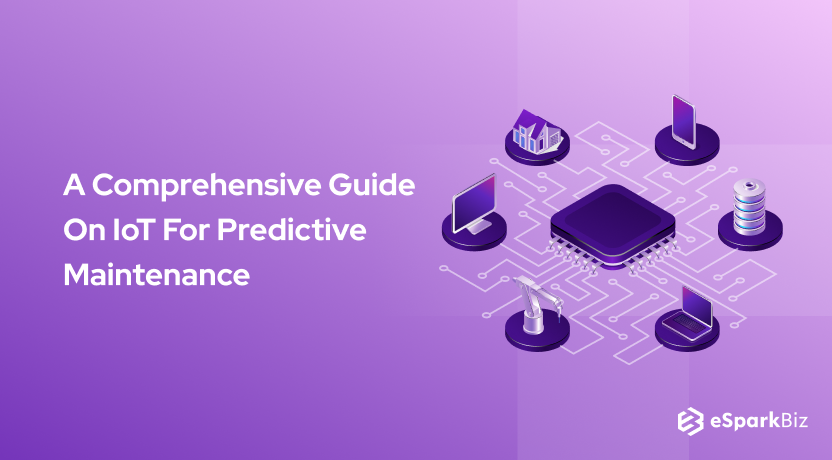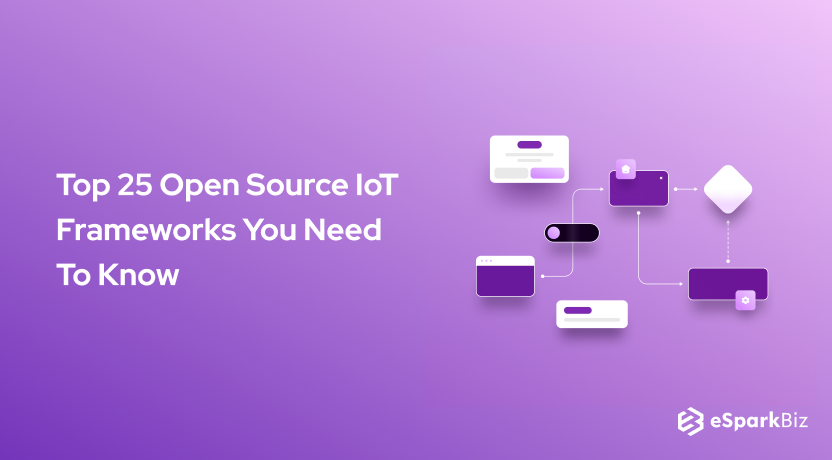The Internet of Things(IoT) can be described as an interconnected system of digital and mechanical machines, computing devices, people, and objects that have unique identifiers. It can transfer data without human interaction. Today we will learn about IoT Predictive Maintenance.
Today, the concept has evolved, and many companies are attempting to incorporate this into modern manufacturing systems. An IoT Predictive Maintenance system simplifies the factory keep by gathering user data from several production equipments.
Several manufacturers are making use of open-source IoT frameworks to avoid ineffective maintenance cost and routine. Let’s look at the benefits of IoT for predictive maintenance.
Why Opt For IoT?
You might be wondering why you should use the Internet of Things applications when you can always go for SCADA which is a tried and tested solution for maintenance activities. A Top-Quality IoT App Development Company can help you here.
In predictive maintenance, you need to process a vast quantity of data and deal with advanced algorithms that you cannot achieve with SCADA.
With a Predictive Maintenance IoT system, you can store a large amount of data and have several computers running machine learning algorithms in parallel. This helps you predict the weak points in the industrial equipment and avoid dangerous accidents.
However, you must build a carefully thought out architecture in order to build a solid IoT Predictive Maintenance solution that can save vital resources by lowering the need for replacing of asset components before they stop working. They can also lower the cost of maintenance by syncing it with the symptoms of asset failures.
Hence, several companies are using Node.js for IoT to reduce an asset’s out of order time by calculating when they must complete the maintenance so that there are minimal chances of asset failure.
Benefits Of IoT

Predictive maintenance based on IoT allows you to optimize, maintain, and monitor assets for increased performance, utilization, and availability.
With real-time monitoring, you can have a better idea of the asset’s performance. This allows for the prediction of machine failure and identification of parts that need to be replaced, thus extending the assets’ life.
Furthermore, IoT Predictive Maintenance allows you to improve the efficiency of field crews. Since you can view asset health from every possible angle, it helps you with scheduling, prioritization, and planning.
It allows you to avoid unplanned downtime that leads to field service crews traveling from another work location to fix the issue.
Now, let’s take a look at the evolution of maintenance over the years.
The Evolution of Maintenance
For decades, companies have been conducting maintenance in the same old way based on the recommendations of manufacturers.
Every piece of industrial equipment comes with recommendations on how to maintain it, based on advice from an R&D or engineering team that’s responsible for creating it.
For an example of schedule-based maintenance, you can consider car leasing. Here, you rent a car and maintain a mileage limit as there is a warranty that backs you up as long as you maintain the car as per the recommendations of the manufacturer. According to the recommendations, you service the vehicle based on mileage or time intervals.
In case something goes wrong with the leased car in between scheduled maintenance events, you need to perform emergency servicing, but this is rarely the case with newly leased vehicles.
This way of conducting maintenance is highly inefficient and outdated. Thanks to technology, we can employ cost-effective and sophisticated methods for solving maintenance issues. Small-scale computing technology has paved the way for engaging in condition-based maintenance.
As a step-up from scheduled maintenance, this technique involves the installation of embedded sensors in industrial equipment. It determines if maintenance is needed or not by studying the actual condition of the asset.
Before, only veteran maintenance teams could perform condition-based maintenance, since sensors were not cheap like they are now.
This involved them inspecting the physical parts of critical equipment, as well as using simple technologies like a pressure meter to study the condition.
IoT Predictive Maintenance Architecture

Let us take a look at a predictive maintenance IoT solution that aims to predict the expiry date of industrial batteries.
Before we delve into the technical details, it is vital that you know about the main variables that decide battery health. These are discharge, voltage, and temperature.
After identifying the variables, sensors are fitted into the batteries to gather data on these three parameters and send them to the cloud so that it can be processed.
Since you cannot pass sensor data to the cloud directly, it has to pass through a gateway. Such gateways are called field gateways, which are physical devices filtering and preprocessing the battery data.
A cloud gateway makes data transmission a safe process while providing connectivity through several protocols that allows the connection of several field gateways. Once the data from predictive maintenance sensors enter the cloud, it enters a streaming data processor.
This data processor allows data to flow continuously and swiftly, efficiently transmitting streams of data to a data lake.
A data lake is a place where the data collected by the predictive maintenance sensors are stored. Since it is raw data, it may contain erroneous, irrelevant, and inaccurate items.
The data inside the data lake consists of a series of sensor readings and when there is a need for gathering data battery health, the system uploads it to a big data warehouse.
The big data warehouse contains structured data in the form of discharge, voltage, and temperature parameters as well as recharge dates, locations, and types of batteries.
Onto The Predictive Models
After the data is ready, the system analyzes it with the help of machine learning algorithms. These algorithms reveal abnormal patterns in the data and divulge hidden data set correlations. IoT predictive maintenance models reflect the recognized data patterns.
By building and training predictive models, you can estimate how much of the batteries’ useful life remains, point out the batteries that have lower than normal capacity, and determine whether one of them is having a self-discharge.
There are two approaches based on which the predictive models are built.
- Regression approach- Here the models tell you how many days are left till a battery reaches the end of its useful life.
- Classification approach- Models that follow this approach tell you whether a battery is under the risk of self-discharging if the battery capacity is lower than usual.
Predictive Maintenance IoT models need to be updated regularly and checked often for accuracy. If the output is quite different from what’s expected, you can revise, restrain, and test them until you get the perfect output.
Before starting with machine learning, one must carry out the required exploratory analytics. This helps in the discovery of patterns and dependencies that offer insights into the data set of machine learning.
To find the most suitable machine learning algorithm, there needs to be a clear assessment of the technical assumptions.
Predictive Maintenance By Industries
Various companies are using these architectural components to create predictive maintenance solutions.
Let us take a look at some predictive maintenance examples industry-wise, achieved through the implementation of IoT web development solutions.
Discrete Manufacturing
These days, discrete manufacturers are employing predictive maintenance IoT to monitor parameters like the health of milling machine spindles. These machines break easily and repairing them is expensive.
With a predictive maintenance solution based on IoT, manufacturers can predict future damage by gathering sensory data from vibration and ultrasonic sensors that are coupled to the spindle. By analyzing the data, they can check the fragile spindles and replace them before they break.
The Volvo Group has deployed a predictive maintenance solution based on IoT that not only predicts the damage done to spindles but also identifies things like motor defects, gearing defects, as well as the spalling and cracking of the rotational parts.
This way, they managed to improve Overall Equipment Effectiveness(OEE) by reducing repair time by 20% and diagnostic time by 70%.
Process Manufacturing
In the process manufacturing industry, paper manufacturing and pulp processing companies use IoT predictive maintenance to monitor the parameters of the paper machines.
Maastricht Mill is one company that installed vibration and temperature sensors in their press rolls and introduced a predictive maintenance solution based on cloud technology to predict damages done to gears and bearings.
The steel industry is another sector where several predictive maintenance examples can be found. In steel plants, there are several furnaces that control the temperature with the help of water cooling panels.
It is possible to prevent equipment failures and production delays, as well as conduct a root cause analysis using a predictive maintenance system.
Oil and Gas

For personnel to physically inspect production equipment in the oil and gas industry is a hazardous prospect. Through IoT predictive maintenance, these companies can point out potential failures and enhance the production of critical assets.
Chevron, for example, has introduced a Predictive Maintenance IoT solution that allows them to identify pipeline and corrosion damages. In fact, if you analyze the IoT Applications and Examples you will find out this thing.
This solution involves the use of sensors set up all across the pipeline to measure aqueous and gaseous H2S/CO2 content, the internal thickness and diameter of the pipeline, and the pH.
Using the predictive maintenance solution, they can fetch live data from the sensors and transmit them to the cloud for analysis, evaluation, and prediction.
According to the US Department of Energy, by making use of predictive maintenance, oil and gas companies can reduce downtime, breakdowns, and maintenance costs.
Electric Power Industry
Companies belonging to the electric power industry can employ IoT Predictive Maintenance to detect flaws in the rotating parts of steam, gas, and wind turbines. Thus, they can take the required action and ensure the power generation is not interrupted.
For this purpose, they would often install vibration sensors on the turbines. The sensor collects data, passing it on to the cloud where they are decrypted with the help of machine learning algorithms.
Florida Power and Light have employed such a system to measure the performance of turbines.
Railways

In order to make sure the rolling stock and the rails are in perfect condition, railway companies are using predictive maintenance sensors to point out braking defects in freight-cars, straightaways and rail curves damages, as well as excessive friction in the bearings and wheels.
This data can reveal unhealthy patterns that can cause breakages. Thus, through predictive maintenance, railways companies can improve velocity, reliability, and safety of the trains, while also reducing train delays due to faulty equipment.
Construction
In the construction industry, professionals use IoT Predictive Maintenance to assess the condition of lifts, loaders, bulldozers, and excavators.
The sensors coupled to a machine can monitor fuel consumption, tyre pressure, engine RPM, and brake temperature.
Komatsu is one construction company that has introduced predictive maintenance sensors in its fleet. These sensors collect critical performance data and send it to the cloud.
This way, they can identify potential problems with the system, as well as the damage done to the static and rotating components.
Business Case For Predictive Maintenance
Traditionally, schedule-based maintenance has always been the method of choice for reducing the risk of plant and equipment failure. But this is a bit problematic because you can’t always determine the condition based on age alone.
As a result, this technique has led to machinery and parts being replaced based on a schedule when in fact they were working.
This maintenance system assumes that the older an equipment is, the more likely it is to fail. This results in lost productivity and unplanned downtime, apart from other unique factors that must be considered.
According to the ARC Advisory Group, 82% of industrial assets show a random pattern of failure. These failures not only damage other equipment but also lead to safety risks.
Also, it leads to unplanned downtime and you need to spend money to rectify the issue urgently. Thus, this technique of maintenance has its limitations.
With a predictive maintenance IoT approach, one can predict failures more accurately through machine learning, analytics, and sensors. This way, companies can perform maintenance only when it is necessary.
Predictive maintenance can reduce factory equipment costs by 40% while cutting down downtime by almost half. So it is not surprising that manufacturers are incorporating predictive maintenance solutions into their businesses.
Tools For Predictive Maintenance: Best Practices
As companies eventually recover from all the initial razzmatazz around predictive maintenance, they will start debating about the advantages and disadvantages of adopting IoT predictive maintenance.
This will present an opportunity to take a leaf out of the book of organizations that are leaders in employing predictive maintenance systems.
The Japanese Multinational company Hitachi has pointed out six techniques and tools that all companies must have to ensure the predictive maintenance programs are functioning as expected. These are as follows:
- Small scale pilot programs at the start
- A technology suite that allows one to aggregate data
- Algorithms that can keep an eye on real-time events and patterns
- Productive workflows
- Service management
- An agreement for change management
Using these best practices, engineers can find it easier to deal with issues like implementation, delivering on a promise, data and technological requirements, etc.
Read also: Discovering The IoT Trends You Should Pay Attention To
Top Predictive Maintenance Companies
IBM
It gets widespread media coverage and has a vast workforce due to which it occupies the top spot. Watson, the data analytics processor, has enabled a key solution known as Predictive Maintenance and Quality.
It monitors equipment data, analyzes it, and sends reports in the form of a health-score. Some predictive maintenance examples include Hydrants from DC Water and Kone’s elevators.
Kone recently started a revolution in elevator maintenance by launching 24/7 connected services, taking a cue from the solution.
SAP
For several years now, the German software company SAP has been displaying how it makes use of IoT predictive maintenance. Today, it is the most sought-after company when it comes to Predictive Maintenance.
This company has implemented its Predictive Maintenance and Service solution for clients like Siemens and Kaeser Kompressoren. SAP has recently unveiled an IoT portfolio known as SAP Leonardo.
Siemens
Siemens has been a leader in industrial automation for a long time now, and as such, it has taken a different approach to predictive maintenance compared to SAP.
In industrial equipment and factory settings using predictive maintenance, it is the automation system that is hugely favored.
Due to the large quantity of data, there is already a basis where a machine learning algorithm can be established. Siemens worked closely with the monitoring services company Azima DLI for implementing a predictive maintenance system for the cooling systems at a NASA Flight Center.
In October 2016, Siemens started a one-year partnership with Deutsche Bahn for a predictive maintenance pilot. This was done to monitor a fleet of trains.
Microsoft
Microsoft Azure is a popular public cloud platform for IoT Predictive Maintenance. As per the market report, predictive maintenance applications are moving from in-situ to cloud systems.
Apart from cloud infrastructure, Microsoft Azure has a couple of preconfigured solutions that aim to help new people get a headstart with the help of analytics engines. These solutions are Remote Monitoring and Predictive Maintenance.
GE
When it comes to IoT predictive maintenance, GE possesses two angles. While GE Digital deals with the analytics and software part, GE Measurements works on the condition monitoring of hardware.
The Predix platform from GE forms the backbone of Asset Performance Management(APM). GE has introduced APM with gas and oil operations.
GE Digital, on the other hand, is working on a digital twin, which is an important Predictive Maintenance analytics basis.
Conclusion
Predictive maintenance based on IoT can extend the life of the equipment, eliminate a large chunk of scheduled maintenance jobs, and reduce the downtime for equipment.
For the predictive maintenance solution to be reliable and mature, there needs to be a sophisticated architecture that focuses on machine learning.
-
How Do You Start Predictive Maintenance?
There are some steps that you need to follow for predictive maintenance. They are as follows:
- Start Small
- Identify PdM Ready Assets
- Identify Resources Required
- Implement Asset Monitoring and Begin Data Collection
- Create Algorithms to Predict Failures
- Apply to Pilot Asset
-
Why Predictive Maintenance Is Important?
With the help of Predictive Maintenance manufacture can lower maintenance costs, extend equipment life, reduce downtime & improve quality.
-
What Are The Type Of Predictive Maintenance?
The type of Predictive Maintenance is as follows:
- Run-to-Failure (RTF) Maintenance
- Preventive Maintenance (PM)
-
What Are Some Of The Popular Predictive Maintenance Tools?
The popular predictive maintenance is listed as follows:
- Fluke Condition Monitoring
- Smart Sensors for Industrial Motors – ABB
- Thermal Imaging Smartphone – Caterpillar
- Connected Machine System – Cisco







